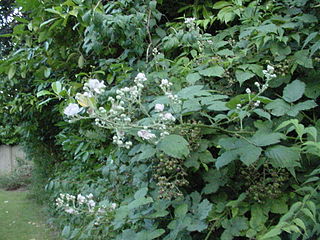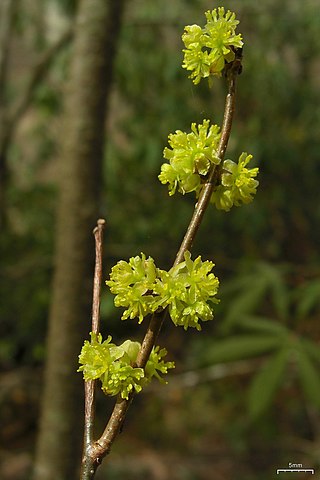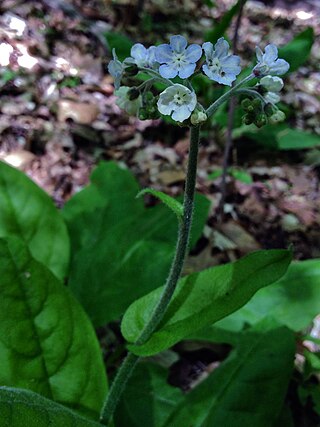
A bramble is any rough, tangled, prickly shrub, usually in the genus Rubus, which grows blackberries, raspberries, or dewberries. "Bramble" is also used to describe other prickly shrubs, such as roses. The fruits include blackberries, arctic brambleberries, or raspberries, depending on the species, and are used to make jellies, jams, and preserves.

The curry tree, Murraya koenigii or Bergera koenigii, is a tropical and sub-tropical tree in the family Rutaceae, native to Asia. The plant is also sometimes called sweet neem, though M. koenigii is in a different family to neem, Azadirachta indica, which is in the related family Meliaceae.

Eremophila is a genus of more than 260 species of plants in the figwort family, Scrophulariaceae all of which are endemic to mainland Australia.. Eremophilas are widespread in the arid areas of Australia, especially Western Australia and range in size from low-growing shrubs to small trees. The petals are joined, at least at their bases, into a tube with the upper petals different in size and shape from the lower ones. Some species have common names including emu bush, poverty bush or fuchsia bush, reflecting the belief that emus eat the fruit, their arid environment or a superficial resemblance to the flowers of plants in the genus Fuchsia.

Lindera benzoin is a shrub in the laurel family, native to eastern North America, ranging from Maine and New York to Ontario in the north, and to Kansas, Texas, and northern Florida in the center and south. Within its native range it is a relatively common plant where it grows in the understory in moist, rich woods, especially those with exposed limestone.

Silene flos-cuculi, commonly called ragged-robin, is a perennial herbaceous plant in the family Caryophyllaceae. This species is native to Europe and Asia, where it is found along roads and in wet meadows and pastures. In Britain it has declined in numbers because of modern farming techniques and draining of wet-lands and is no longer common. However, it has become naturalized in parts of the northern United States and eastern Canada.

Viburnum trilobum is a species of Viburnum native to northern North America, from Newfoundland west to British Columbia, south to Washington state and east to northern Virginia. It is very closely related to the European and Asian Viburnum opulus, and is often treated as a variety of it, as Viburnum opulus L. var. americanum Ait., or as a subspecies, Viburnum opulus subsp. trilobum (Marshall) Clausen.

Billbergia is a genus of flowering plants in the family Bromeliaceae, subfamily Bromelioideae.

Latania, commonly known as latan palm or latania palm, is a genus of flowering plant in the palm tree family, native to the Mascarene Islands in the western Indian Ocean.

Floerkea is a monotypic genus of plants in the meadowfoam family containing the sole species Floerkea proserpinacoides, which is known by the common names false mermaid, false mermaidweed, and floerkea. This tiny wildflower is native to many parts of North America, where it is found in moist areas such as shady forests. It is a fleshy, annual herb which grows short stems which may lie flat on the ground, tangle into a clump, or grow somewhat erect. The foliage is hairless and shiny. The leaves are divided into many oval-shaped, pointed leaflets up to 2 cm (0.79 in) long. The flower is a cup of pointed green sepals containing three tiny white spoon-shaped petals and a bunch of stamens with yellow anthers. Growing in the center of the flower are the two to three fruits, which are bumpy, spherical nutlets.

Elaeocarpus bancroftii, commonly known as Kuranda quandong, Johnstone River almond, ebony heart, grey nut, or nut tree is a large rainforest tree in the family Elaeocarpaceae which is endemic to Queensland. It has coriaceous leaves, attractive white flowers and relatively large fruit containing an edible kernel.

Calopogonium is a genus of flowering plants in the legume family, Fabaceae. It belongs to the subfamily Faboideae. Calopogunium mucunoides is a vine that was introduced into Australia as a pasture legume. It has become naturalized in disturbed sites, waste areas and crops along roadsides and waterways and on the edges of rainforests in the wetter tropical regions of Northern Australia. It is most common in the Darwin region and in surrounding bush land and has also become a weed in Kakadu National Park. In these areas, populations are extending rapidly and it has been observed to form dense mats that smother native vegetarian.

Franklandia is a genus of small shrubs in family Proteaceae, commonly known as lanolin bushes. It is endemic to Southwest Australia.

Brabejum is a genus of a single species of large evergreen tree, Brabejum stellatifolium in the family Proteaceae, commonly called wild almond, bitter almond or ghoeboontjie. It is restricted in the wild to South Africa's Western Cape province, where it grows in thickets along the banks of streams. The plant is of botanical interest as being Africa's only member of the large grevilleoid subfamily. It is a bushy small tree with branches widely at ground level and numerous erect vigorous stems. Leaves grow up to 6 in (15 cm) long, narrow and bluntly toothed, appear at intervals along the branches, mostly in whorls of 6. In summer, the plant bears white flowers densely crowded on spikes arising from rusty buds at the leaf axils. The fruits to 2 in (5 cm) long, magenta to reddish brown, similar to an almond, appear in autumn. The nut is too bitter to eat; however, in earlier times it was boiled, roasted, and ground to make a "coffee" drink.

Andersonglossum virginianum, known as southern wild comfrey, is a flowering plant in the borage family native to North America. It is also sometimes called blue houndstongue.

Oxera splendida is an evergreen vine in the family Lamiaceae which produces white, fragrant flowers and white, egg-shaped fruit. It naturally is occurs in the tropical rain forests of tropical Asia and Australia and is often sighted along rain forest margins such as roads. Some common names include October Glory, Glory Vine, Potato Vine and Fragrant Faradaya. Australian indigenous names include Garanggal used from Cairns to Yarrabah, Buku used in the Tully River area, Koie-yan used at Dunk Island and Djungeen used by the Girramay clan.

Hakea leucoptera, commonly known as silver needlewood, needle hakea, pin bush or water tree and as booldoobah in Koori language, is a shrub or small tree with rigid, cylindrical, sharply pointed leaves and white, cream-coloured or yellow flowers in late spring and early summer. It is widespread and common in central parts of the Australian mainland.

Larrea divaricata, commonly known as chaparral, is a small evergreen bush in the family Zygophyllaceae. It is native to arid regions of South America, where it is known as jarilla or jarillo. It was first described in 1800 by the Spanish botanist Antonio José Cavanilles.

Billardiera fusiformis is a species of plant in the family, Pittosporaceae, which is endemic to Western Australia.

Annona aurantiaca is a species of plant in the family Annonaceae. It is native to Brazil. João Barbosa Rodrigues, the Brazilian botanist who first formally described the species, named it after its orange colored petals.

Volkamer lemon, often misspelled Volckamer lemon, is known as 沃 尔卡默柠檬 in Chinese, citron de Volkamer in French, limone Volkameriano in Italian, and chanh Volkamer in Vietnamese. It is a Citrus hybrid cultivated for its edible fruit. The specific epithet (volkameriana) honors German botanist Johann Christoph Volkamer.























